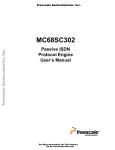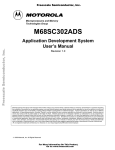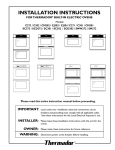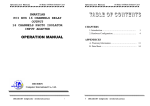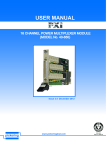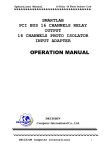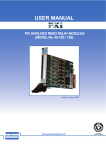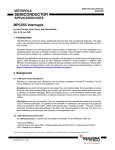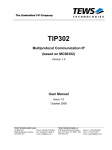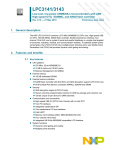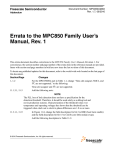Download Errata to MC68SC302 Passive ISDN Protocol Engine User`s Manual
Transcript
Freescale Semiconductor, Inc. Errata to MC68SC302 Passive ISDN Protocol Engine User’s Manual This errata describes corrections to the MCSC302 Passive ISDN Protocol Engine User’s Manual (MC68SC302UM/AD). For convenience, the section number and page number of the errata item in the user’s manual are provided. The section and page numbers of new errata entries are boldfaced. Errata to MC68SC302 User’s Manual Freescale Semiconductor, Inc... 7/15/98 For More Information On This Product, Go to: www.freescale.com Freescale Semiconductor, Inc. Section/Page Changes Global Programming Advisory—Soft Reset. To perform a soft reset on the SC302, first disable access to the serial EEPROM and then re-enable access by clearing and then setting the SCP enable bit, SPMODE[EN]. The actual reset can then be performed through the command register by setting CR[RST] (and CR[FLG]). Note that the software should wait for the CP to clear CR[FLG] before assuming the soft reset has been completed. Freescale Semiconductor, Inc... Assuming 0xFFF0 is the address port and 0xFFF2 is the data port, the following code implements the advisory. ouportw(0xFFF0,0x08B0); // Address of SCP mode register ouportw(0xFFF2,0x1400); // Disable SCP ouportw(0xFFF2,0x1500); // Enable SCP ouportw(0xFFF0,0x0860); // Address of CR register ouportw(0xFFF2,0x8100); // Soft reset 4.2, 4-2 Add the following note concerning the reset bit of the command register CR[RST]: ‘The software must wait a minimum of 2ms after setting CR[RST] before the SC302 will respond to ISA or PCMCIA accesses; that is, the software should wait for the CP to clear CR[FLG].’ 4.4.2, 4-14 Change the last sentence of the paragraph describing SIMASK to read: ‘Note that the serial data strobes, SDS1 and SDS2, are asserted for the bits set in the associated B-channel mask, and negated for the bits cleared in the SIMASK register.’ 5.4.1, 5-7 Change Table 5-3 to read: Table 5-3. Resource Data Layout Address 2 Name Register-Destination 0x00–01 Serial EEPROM Type/Mode — 0x02–03 Reserved—must be cleared. — 0x04 Serial EEPROM Type — 0x05–06 Reserved—must be cleared. — 0x07 Implementation-specific information 0x22 0x08 First byte of Standard Resource Data — Errata to MC68SC302 Passive ISDN Protocol Engine User’s Manual For More Information On This Product, Go to: www.freescale.com Freescale Semiconductor, Inc. Section/Page Changes 5.4.1, 5-9 In Figure 5-5, move the words ‘Serial Number’ (originally next to ‘Byte 3’) down one row to align with ‘Byte 0’. 5.4.3, 5-10 Clarify the I/O configuration programming as follows: Byte 0—I/O port descriptor tag. (value = 0b0100_0111 = 0x47) Byte 1—Information byte. The SC302 supports 16-bit decoding, therefore bit 0 = 1, and the reserved bits 7–1 = 0. (value = 0x01) Freescale Semiconductor, Inc... 5.4.4, 5-11 Change the memory configuration programming as follows: Byte 0—Memory range descriptor tag (value = 0b1000_0001 = 0x81) Bytes 1–2—Length of the memory range descriptor. Bits 7–0 = 0x09 and bits 15–8 = 0x00, giving a length of 0x0009. Byte 3—Information field. [Reserved]_[Not ExpansionROM] _[Not shadowable]_[8/16-bit supported]_[Decode support Range Length]_[Non-cachable]_[Writable] (value = 0b0_0_0_1_0_0_0_1 = 0x11) 5.5, 5-17 Change the note directly under the ISI register to read: ‘Loaded from 0x07 in the byte serial device’ 5.5, 5-19 At the top of the page, add a closing parenthesis—(Vendor Defined). 5.7, 5-21 The descriptions of IMRNGH and IMRNGL has changed; see errata for 6.6.2, 6-14 below. 6.4.5, 6-6 In Table 6-1, exchange the places of IMRNGH and IMRNGL. 6.6.1, 6-9 In the description of the configuration option register’s interrupt mode bit, COR[LEVIREQ], add the following note: ‘The software must set COR[LEVIREQ] since the SC302 supports only level interrupts.’ 6.6.1, 6-10 Change ‘Intr’ to read ‘INTR’. 6.6.2, 6-12 Correct the attribute address of the ACTIVE register to $2000060. 6.6.2, 6-13 In the desription of ACTIVE[ACTV]—Active Bit, change all references of ‘ISA’ to ‘PCMCIA’. Errata to MC68SC302 Passive ISDN Protocol Engine User’s Manual For More Information On This Product, Go to: www.freescale.com 3 Freescale Semiconductor, Inc. Section/Page Changes 6.6.2, 6-14 Replace the descriptions of IMRNGH and IMRNGL with the following. Note the attribute address changes. IMRNGH Attribute address $2000086 7 6 5 4 3 2 1 0 RL[23]=RL[1 2] RL[22]=RL[1 2] RL[21]=RL[1 2] RL[20]=RL[1 2] RL[19]=RL[1 2] RL[18]=RL[1 2] RL[17]=RL[1 2] RL[16]=RL[1 2] 0 0 0 0 0 0 0 0 7 6 5 4 3 2 1 0 RL[15]=RL[1 2] RL[14]=RL[1 2] RL[13]=RL[1 2] RL[12] RL[11]=0 RL[10]=0 RL[9]=0 RL[8]=0 0 0 0 0 0 0 0 0 Freescale Semiconductor, Inc... IMRNGL Attribute address $2000088 The registers are active in the configuration state. RL23–RL8 — Range length. RL23–RL8 corresponds to bit 23 through bit 8 of the upper limit of memory range. Bit7–bit 0 are always zero. RL11–RL8 and RL23–RL13 of the range length are read only. RL12 is read/write and used as an enable bit for the internal memory range. RL12 1 = Internal memory (4 Kbyte) is enabled. On reads from the range length, the returned value indicates a 4-Kbyte memory range (even if a larger value was written by the software). 0 = Internal memory (4 Kbyte) is disabled; I/O accesses to the internal space are possible if the related I/O base address is not 0. On reads from the range length, 0 is returned. NOTES: The memory range length is defined as a mask of address bit23–bit8. If a mask bit is set, the corresponding bit in the address is used in a comparator for address matching. For PCMCIA operation, mask the internal 4-KB address space (IMRNGH=0xFF, IMRNGL=0xF0) and set ACTIVE[ACTV]. The memory upper limit is defined as being one byte greater than the memory resource assigned. 6.6.2, 6-13 PCMCIA access to the Communication Controller Registers (CCR) in serial EEPROM mode: In serial EEPROM mode, the CCRs can only be accessed via common memory mode accesses instead of attribute memory accesses as indicated in the manual in section 6.4.2. In fact, all areas of the CCMR 4 Errata to MC68SC302 Passive ISDN Protocol Engine User’s Manual For More Information On This Product, Go to: www.freescale.com Freescale Semiconductor, Inc. Freescale Semiconductor, Inc... (include DPR and the CCR) can be accessed with common memory accesses (asserting A25). Figure 6-3 should be disregarded and Figure 6-4 used instead (the CIS will still reside in the first locations of DPR). Home Page: www.freescale.com email: [email protected] USA/Europe or Locations Not Listed: Freescale Semiconductor Technical Information Center, CH370 1300 N. Alma School Road Chandler, Arizona 85224 (800) 521-6274 480-768-2130 [email protected] Europe, Middle East, and Africa: Freescale Halbleiter Deutschland GmbH Technical Information Center Schatzbogen 7 81829 Muenchen, Germany +44 1296 380 456 (English) +46 8 52200080 (English) +49 89 92103 559 (German) +33 1 69 35 48 48 (French) [email protected] Japan: Freescale Semiconductor Japan Ltd. Headquarters ARCO Tower 15F 1-8-1, Shimo-Meguro, Meguro-ku Tokyo 153-0064, Japan 0120 191014 +81 2666 8080 [email protected] Asia/Pacific: Freescale Semiconductor Hong Kong Ltd. Technical Information Center 2 Dai King Street Tai Po Industrial Estate, Tai Po, N.T., Hong Kong +800 2666 8080 [email protected] For Literature Requests Only: Freescale Semiconductor Literature Distribution Center P.O. Box 5405 Denver, Colorado 80217 (800) 441-2447 303-675-2140 Fax: 303-675-2150 LDCForFreescaleSemiconductor @hibbertgroup.com Information in this document is provided solely to enable system and software implementers to use Freescale Semiconductor products. There are no express or implied copyright licenses granted hereunder to design or fabricate any integrated circuits or integrated circuits based on the information in this document. Freescale Semiconductor reserves the right to make changes without further notice to any products herein. Freescale Semiconductor makes no warranty, representation or guarantee regarding the suitability of its products for any particular purpose, nor does Freescale Semiconductor assume any liability arising out of the application or use of any product or circuit, and specifically disclaims any and all liability, including without limitation consequential or incidental damages. “Typical” parameters which may be provided in Freescale Semiconductor data sheets and/or specifications can and do vary in different applications and actual performance may vary over time. All operating parameters, including “Typicals” must be validated for each customer application by customer’s technical experts. Freescale Semiconductor does not convey any license under its patent rights nor the rights of others. Freescale Semiconductor products are not designed, intended, or authorized for use as components in systems intended for surgical implant into the body, or other applications intended to support or sustain life, or for any other application in which the failure of the Freescale Semiconductor product could create a situation where personal injury or death may occur. Should Buyer purchase or use Freescale Semiconductor products for any such unintended or unauthorized application, Buyer shall indemnify and hold Freescale Semiconductor and its officers, employees, subsidiaries, affiliates, and distributors harmless against all claims, costs, damages, and expenses, and reasonable attorney fees arising out of, directly or indirectly, any claim of personal injury or death associated with such unintended or unauthorized use, even if such claim alleges that Freescale Semiconductor was negligent regarding the design or manufacture of the part. For More Information On This Product, Go to: www.freescale.com





